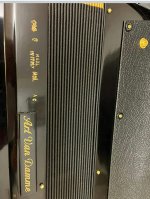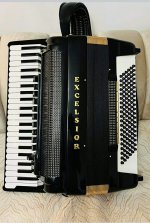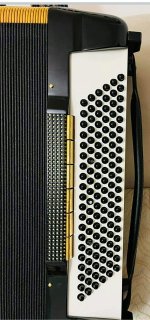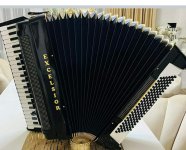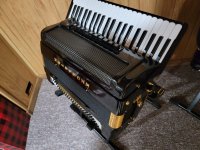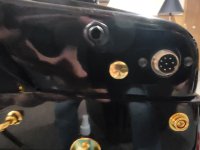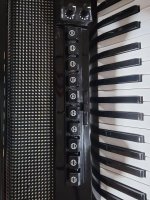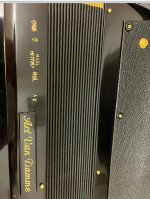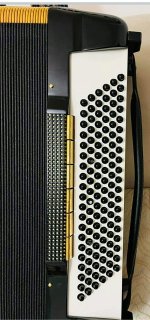You are using an out of date browser. It may not display this or other websites correctly.
You should upgrade or use an alternative browser.
You should upgrade or use an alternative browser.
Please help
- Thread starter Dano458
- Start date
Hi Dano
Not sure what details you already know / you're looking for.
As I once had the pleasure to play on one I know at least a few:
The AC Symphony Gold is Excelsiors top-line instrument - an evolution of the famous "Continental"-series.
By default ct comes with a 42 (incl. low E)/120 - 4/6 configuration.
When you opt for the "Art van Damme" Edition you get a 16/16c/8c/4 (where c means in cassotto aka double-tone-chamber).
Also AvD editions by default don't come the the Sordino (which is a standard feature of the Symphony Gold).
This instrument seems a custom built:
1) it comes with 44 treble keys (it goes up to high C, but misses the low E of a 45/42 keyboard)
2) 10 treble switches (standard is 13) suggest that either it's a 3 chorus instrument with sordino open/mute switches or 4 chorus with some combinations missing
3) the AvD label suggests that it's a model w/o sordino and LLMH config.
A photo from the switch-ensemble will disclose details on treble reed-set.
I liked the instrument and was very much tempted to buy it - finally found a nice, somewhat cheaper alternative.
Not sure what details you already know / you're looking for.
As I once had the pleasure to play on one I know at least a few:
The AC Symphony Gold is Excelsiors top-line instrument - an evolution of the famous "Continental"-series.
By default ct comes with a 42 (incl. low E)/120 - 4/6 configuration.
When you opt for the "Art van Damme" Edition you get a 16/16c/8c/4 (where c means in cassotto aka double-tone-chamber).
Also AvD editions by default don't come the the Sordino (which is a standard feature of the Symphony Gold).
This instrument seems a custom built:
1) it comes with 44 treble keys (it goes up to high C, but misses the low E of a 45/42 keyboard)
2) 10 treble switches (standard is 13) suggest that either it's a 3 chorus instrument with sordino open/mute switches or 4 chorus with some combinations missing
3) the AvD label suggests that it's a model w/o sordino and LLMH config.
A photo from the switch-ensemble will disclose details on treble reed-set.
I liked the instrument and was very much tempted to buy it - finally found a nice, somewhat cheaper alternative.
Last edited:
Thank you so much for your time in responding to my request. Some of the things you are referencing, I'm not understanding since I'm not very techy. Please explain some of the terms:Hi Dano
Not sure what details you already know / you're looking for.
As I once had the pleasure to play on one I know at least a few:
The AC Symphony Gold is Excelsiors top-line instrument - an evolution of the famous "Continental"-series.
By default ct comes with a 42 (incl. low E)/120 - 4/6 configuration.
When you opt for the "Art van Damme" Edition you get a 16/16c/8c/4 (where c means in cassotto aka double-tone-chamber).
Also AvD editions by default don't come the the Sordino (which is a standard feature of the Symphony Gold).
This instrument seems a custom built:
1) it comes with 44 treble keys (it goes up to high C, but misses the low E of a 45/42 keyboard)
2) 10 treble switches (standard is 13) suggest that either it's a 3 chorus instrument with sordino open/mute switches or 4 chorus with some combinations missing
3) the AvD label suggests that it's a model w/o sordino and LLMH config.
A photo from the switch-ensemble will disclose details on treble reed-set.
I liked the instrument and was very much tempted to buy it - finally found a nice, somewhat cheaper alternative.
Sordino, AvD, LLMH, Cassotto.
Again, thank you for your time in helping me understand. I'll attach a couple more photos
Attachments
Thank you so much for your time in responding to my request. Some of the things you are referencing, I'm not understanding since I'm not very techy. Please explain some of the terms:expand...
Sordino, AvD, LLMH, Cassotto.
Again, thank you for your time in helping me understand. I'll attach a couple more photos
Dingo40
Been here for ages!
This is really a job for our members Paul Debra and JimD, but, until they come along, I'll have a goSome of the things you are referencing, I'm not understanding since I'm not very techy. Please explain some of the terms:
Sordino, AvD, LLMH, Cassotto.
A "sordino" is a mechanism for muting and softening the sound coming from the instrument that can be switched on or off at will.
"AvD" simply refers to Art Van Danme, a famous jazz accordionist of the middle 20th century ( lots of videos on YouTube) who gave his name to a particular reed set arrangement as used in the accordion he himself played.
This reed arrangement has 4 sets of reeds ( or voices) comprising of two Low reed sets, a Middle reed set and a High reed set. Hence the acronym "LLMH".
The "Low" reed sets produce a range of sounds approximating to a 16 foot long organ pipe.
The "Middle" reed set approximate to the 8 foot long organ pipe.
The "High" reed set approximates to the 4 foot long organ pipe.)
"Cassotto" is a compartment built into the structure of the accordion for housing one or two sets of reeds with the intention of mellowing the sound they produce, a kind of (but not exactly) permanent sordino.
I'll now retire and let Paul and Jim correct my errors or omissions!
Last edited:
Thank you again for your time and for explaining everything to me.
Based on what you have shared with me, it would seem that I have a very fine Excelsior accordion, likely a custom version with the 44/120 configuration.
Thanks again.
Based on what you have shared with me, it would seem that I have a very fine Excelsior accordion, likely a custom version with the 44/120 configuration.
Thanks again.
Thank you very much Dingo for chiming in - perfectly explained.
Sorry Dano for using a bunch of acronyms - bad habit from my professional career; don’t have a better excuse than this was very common in my previous company, which was a big US tech-corp.
You definitely have a top-notch instrument, from the photos in looks in great condition - if it only sounds half as good as it looks you should regard yourself a lucky man.
It definitely is an Art-van-Damme edition of Excelsiors AC Continental series, which by default came with 44 treble-keys in the Symphony Gold chassis. By default it came w/o the Sordino as Art van Damme obviously didn’t use this feature a lot (a kind of Jalousie beneath the grille to make the tone even more mellow by damping harmonics) but you could order it as an option (the Symphony Gold has it by default). I can’t zoom in enough to decode the switch symbols, therefore cannot tell you wether or not it has a “mute” switch closing this Sordino. I believe there’s at least one with a dot centered between 2 horizontal lines. That represents the 8” (or M) reed set. A dot “below” (means closer the the keyboard) signals the 16” (or L) reed-set; a dot above the 4”( =H) set. If you play a note with the M-switch enabled, it will sound 1 octave higher with the H-switch, resp 1 octave lower with the L-switch.
Should there be a switch with 2 “adjacent” dots (between or below the double-line) you have 2 reed-sets of the same pitch with one of them “in cassotto”. As explained by Dingo the reed-set in cassotto is “hidden” in an extra-compartment which also impacts the sound (again in sounds more mellow). The dots may be solid and “non-filled” (or have different sizes) to indicate the reed-set inside resp. Outside the chamber. I can’t tell you which one is which, but you should be able to notice the difference.
Also i can’t tell you wether your instrument is a 3-reed-set or 4-reed-set version (AVD3 or AVD4) - that would require a close-up shot to see all register symbols. Art van Damme typically played a 3-chorus version.
In any case a jewel with a 5-digit list-price; hope it will be taken care and played regularly - that’s it was built for.
Best regards from Bavaria to Michigan - I spent quite a few biz-trips to IL.
Sorry Dano for using a bunch of acronyms - bad habit from my professional career; don’t have a better excuse than this was very common in my previous company, which was a big US tech-corp.
You definitely have a top-notch instrument, from the photos in looks in great condition - if it only sounds half as good as it looks you should regard yourself a lucky man.
It definitely is an Art-van-Damme edition of Excelsiors AC Continental series, which by default came with 44 treble-keys in the Symphony Gold chassis. By default it came w/o the Sordino as Art van Damme obviously didn’t use this feature a lot (a kind of Jalousie beneath the grille to make the tone even more mellow by damping harmonics) but you could order it as an option (the Symphony Gold has it by default). I can’t zoom in enough to decode the switch symbols, therefore cannot tell you wether or not it has a “mute” switch closing this Sordino. I believe there’s at least one with a dot centered between 2 horizontal lines. That represents the 8” (or M) reed set. A dot “below” (means closer the the keyboard) signals the 16” (or L) reed-set; a dot above the 4”( =H) set. If you play a note with the M-switch enabled, it will sound 1 octave higher with the H-switch, resp 1 octave lower with the L-switch.
Should there be a switch with 2 “adjacent” dots (between or below the double-line) you have 2 reed-sets of the same pitch with one of them “in cassotto”. As explained by Dingo the reed-set in cassotto is “hidden” in an extra-compartment which also impacts the sound (again in sounds more mellow). The dots may be solid and “non-filled” (or have different sizes) to indicate the reed-set inside resp. Outside the chamber. I can’t tell you which one is which, but you should be able to notice the difference.
Also i can’t tell you wether your instrument is a 3-reed-set or 4-reed-set version (AVD3 or AVD4) - that would require a close-up shot to see all register symbols. Art van Damme typically played a 3-chorus version.
In any case a jewel with a 5-digit list-price; hope it will be taken care and played regularly - that’s it was built for.
Best regards from Bavaria to Michigan - I spent quite a few biz-trips to IL.
Thank you very much for the wonderful information. The accordion is currently in transit to me and should arrive around the 20th. When it gets here, I will take some close up photos of the switches and post them here for further clarification.
Again, I appreciate the assistance, and I look forward to the enjoyment this wonderful instrument will bring. Have a great evening.
Again, I appreciate the assistance, and I look forward to the enjoyment this wonderful instrument will bring. Have a great evening.
The usual reaction when being told someone has a valuable instrument is "I cannot wait to sell it". It's nice to hear "I cannot wait to play it" for a change.Thank you very much for the wonderful information. The accordion is currently in transit to me and should arrive around the 20th. When it gets here, I will take some close up photos of the switches and post them here for further clarification.
Again, I appreciate the assistance, and I look forward to the enjoyment this wonderful instrument will bring. Have a great evening.
If the Excelsior letters are crooked, that may be a sign of a repair? Normally from the factory they are NEVER crooked and are stuck on with adhesive strong enough that for the most part outlast the accordion.If the accordion name on the front has crooked lettering, how can you adjust it? Is it glued on?
Or it could have simply been a previous owner that was clumsy and ripped off the letters, requiring replacement... and did a lousy job.
Yes they are glued on... but be careful, if they used something like a super glue to put them back on, they may have bonded to the celluloid and removing them could damage it.
Hi guys, just received my new accordion from Belgium. I was able to take a photo of the switches to help identify what it has internally, but I also noticed that it has a multi pin connector on it that I didn't see at the time of purchase. I'm hoping to find out more about the accordion through this wonderful group of people that frequent this forum. I will attach photos and wait for a reply. Thank you in advance for your time and knowledge should you reply to my post.
Attachments
Congratulations Dano for acquiring this beautiful instrument.
It's definitely an AVD3 the Art-van-Damme special edition of Excelsiors AC (aka Continental) model.
It's a 3 chorus version and it's said Art-van-Damme used exactly this configuration.
It comes with a double tone-chamber (aka cassotto) with 16" and 8" in cassotto and one 16" set à cassotto.
You should hear a clear difference when you switch between the two 16" registers (2nd and 3rd from top) especially when playing higher notes.
I presume the one with the centred dot (below the double line) is the one in cassotto - it should sound sound very smooth and mellow, the one with the offset dot presumably represents the à cassotto reed-set sounding a bit brighter.
The switches offer 6 different sound-sets, some sets are repeating to enable quick sound changes regardless whether you play low or high notes.
Surprisingly the "master" (both 16" and the 8" = 3 dots) is missing, eventually there's a "palm-switch" (can't see it from the photos).
It comes with a 6-chorus bass and should offer strong bass sounds.
I can't tell you anything on the 2(?) connectors. I presume it's the power-supply (the 8-pin connector) for the built-in microphone system or a MIDI HW though 8 pins seems a bit too many for just a power-supply. I'm speculating here, though as it's the same connector as Excelsiors power-supply for their MIDIVox-system. The 6,3mm jack might be the microphone signal outputs.
I'm not exactly a fan of the fretsaw decorated grilles - I prefer more clear, straight designs and like the AC (Gold) design a lot.
In any case a very nice instrument - hope we can here a soundcheck soon.
It's definitely an AVD3 the Art-van-Damme special edition of Excelsiors AC (aka Continental) model.
It's a 3 chorus version and it's said Art-van-Damme used exactly this configuration.
It comes with a double tone-chamber (aka cassotto) with 16" and 8" in cassotto and one 16" set à cassotto.
You should hear a clear difference when you switch between the two 16" registers (2nd and 3rd from top) especially when playing higher notes.
I presume the one with the centred dot (below the double line) is the one in cassotto - it should sound sound very smooth and mellow, the one with the offset dot presumably represents the à cassotto reed-set sounding a bit brighter.
The switches offer 6 different sound-sets, some sets are repeating to enable quick sound changes regardless whether you play low or high notes.
Surprisingly the "master" (both 16" and the 8" = 3 dots) is missing, eventually there's a "palm-switch" (can't see it from the photos).
It comes with a 6-chorus bass and should offer strong bass sounds.
I can't tell you anything on the 2(?) connectors. I presume it's the power-supply (the 8-pin connector) for the built-in microphone system or a MIDI HW though 8 pins seems a bit too many for just a power-supply. I'm speculating here, though as it's the same connector as Excelsiors power-supply for their MIDIVox-system. The 6,3mm jack might be the microphone signal outputs.
I'm not exactly a fan of the fretsaw decorated grilles - I prefer more clear, straight designs and like the AC (Gold) design a lot.
In any case a very nice instrument - hope we can here a soundcheck soon.
Last edited:
Ventura
Been here for ages!
this is the 8 pin connector that is found on MIDIVOX equipped models
i have never heard of a "hidden" midivox version, so i am left to
wonder if this specific accordion was originally equipped with a MIDIvox system
and then it was removed, or simply a new front Grille was ordered when
the electronics were removed
if it had a MIDIVOX in it at one time, there are likely some leftover
physical clues inside, like popping the grill and seeing what, if anything,
that connector is still connected to
did the seller offer any info as to the provenance of this accordion ?
is this a CEMEX or PIGINI era build ?
looks like a fine accordion either way
i have never heard of a "hidden" midivox version, so i am left to
wonder if this specific accordion was originally equipped with a MIDIvox system
and then it was removed, or simply a new front Grille was ordered when
the electronics were removed
if it had a MIDIVOX in it at one time, there are likely some leftover
physical clues inside, like popping the grill and seeing what, if anything,
that connector is still connected to
did the seller offer any info as to the provenance of this accordion ?
is this a CEMEX or PIGINI era build ?
looks like a fine accordion either way
check with @Alan Polivka . He wass able to determine the year that my Excelsior NY was manufactured. He may be able to date yours.Would you be able to identify the year of manufacturer of the accordion?
Thank you both for your replies, I appreciate your time and knowledge. The accordion came from Belgium, so I'm not clear on any origin work on the unit. I've reached out to the previous owner regarding the pin connector and am awaiting his reply.
Just spoke with the previous owner. He claims the accordion has a bass MIDI unit which he was void of the cable associated.
I'm not really sure what that means or how it would alter the sound amplified.
Years ago when I played professionally, I would have been interested in following up with a purchase of a cable. Although, if I knew where to explore that whole concept, I probably would. At this point of my life, I bought the accordion to enjoy at home and with a few of my accordion buddies. So glad I was able to purchase it, as it is a very impressive instrument. Thanks everyone for trying to help Mr. I appreciate your time.
I'm not really sure what that means or how it would alter the sound amplified.
Years ago when I played professionally, I would have been interested in following up with a purchase of a cable. Although, if I knew where to explore that whole concept, I probably would. At this point of my life, I bought the accordion to enjoy at home and with a few of my accordion buddies. So glad I was able to purchase it, as it is a very impressive instrument. Thanks everyone for trying to help Mr. I appreciate your time.
Ventura
Been here for ages!
then there would likely be one bass shift that can
"mute" the bass reeds when using MIDI bass
having the sound of an "upright" bass on the left hand
was a popular preference for many gigging Jazz players who
worked SOLO gigs, hence a minimalist MIDI internal setup
to output MIDI was added on to some accordions
"mute" the bass reeds when using MIDI bass
having the sound of an "upright" bass on the left hand
was a popular preference for many gigging Jazz players who
worked SOLO gigs, hence a minimalist MIDI internal setup
to output MIDI was added on to some accordions
Similar threads
- Replies
- 1
- Views
- 86
- Replies
- 1
- Views
- 72
- Replies
- 5
- Views
- 151
- Replies
- 11
- Views
- 228
- Replies
- 5
- Views
- 196

